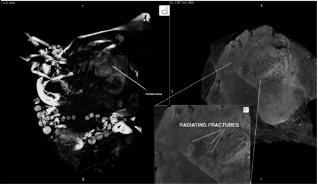Human Sacrifice in the Ancient Near East. Plenumsvortrag von David Usieto Cabrera.
A Blogpost by Rebekka Pabst
On June 18, the members of the GRK 1876 "Early Concepts of Humans and Nature" met again for an online plenary session. During this meeting near eastern archaeologist David Usieto Cabrera presented his dissertation project "Human Sacrifice in the Ancient Near East", which he had started in October 2019.
Aim of the dissertation project
For his dissertation project, David Usieto Cabrera plans to systematically investigate the ritual practices of human sacrifice in the ancient Near East for the first time using archaeological records. He understands human sacrifice as a departure from ordinary burial customs that fulfil a different social and ideological role. For his research he focuses on archaeological remains from the Bronze Age (3rd millennium BC to late 2nd millennium BC). The reason for this lies in the increase of such practices during this period, perhaps as a result of social systemic stress of early states-level societies, which is documented by numerous archaeological sources. The importance of the archaeological sources must be overestimated, since there are no written or iconographic sources on human sacrifices, archaeological vestiges remain key in order to have a direct emic perspective.
Research Questions
David Usieto Cabrera is particularly interested in concepts behind human sacrificial ritual practices. What made a human sacrifice even necessary in the first place? Moreover, he aims to analyze the treatment of bodies and the role individuals may have had. In doing so, he would like to examine the ideas behind the treatment of the bodies, which can vary greatly. In addition, the origin of individuals had a very important role as it points out the variety and rare data in comparison to ancient neighbouring societies, and as opposed to what have been established before, not only slaves and prisoners of war were selected, but also members of higher social classes or potential court members.
 |
Fig.1: CT-scan of a skull-trauma caused by a blow to the head (Baadsgaard et. al 2012)
Potential Indicators
In order to create a theoretical framework that helps recognizing human sacrifice in the field, David Usieto Cabrera suggests to focus on the following preliminary indicators following recent studies (Recht 2018):
· Human skeletal remains in sacred contexts
· Patterns in the skeletal remains suggest a selective process, based on, e.g. age, sex, or bodily deformities
· Simultaneous burial of several people
· Treatment of at least one individual appears differently; also signs of staging the interments
· Evidence of violence (cause of death, binding, other types of submission)
· Human remains associated with the construction of architecture (especially foundations or later additions)
· Similarity in treatment of animal and human skeletal remains, especially where sacrifice is suspected for the animal remains
· Abnormal context/treatment of body in relation to the area and period
 |
Fig.2: The Bodies in Position in the Great Death-Pit PG/1237 (Woolley 1934)
Distinction of human sacrifice
At the end of his lecture David Usieto Cabrera presented various potential subgroups of human sacrificial practices based on archaeological remains. He would like to distinguish between Symbolic/Dramatic Sacrifice, Retainer Sacrifice and Foundation Sacrifice (Schwartz 2012)
Symbolic/Dramatic Sacrifice: Here, human remains may be found in sacred contexts or belonging in sacred landscapes. Bodies often show evidence of violent death or at least violent treatment (e. g. binding of limbs), and analysis of the deposition shows no difference in the treatment of animal remains.
Retainer sacrifice: This kind of sacrifice happened after the death of a ruler. Individuals were killed in order to continue to serve their master/ruler in the afterlife, giving up their life willingly (not implying the cause of death but rather the act of conscious willingness). Potential both high and low ranking individuals were buried in the same context, possibly in a primary burial. A well-known example of this type is the Great Death Pit PG/1237 of the Royal Tombs of Ur.
Foundation Sacrifice: This subgroup suggests the presence of human remains (mostly infants) underneath architectural structures of in walls of buildings.
To sum up, the lecture of David Usieto Cabrera showed that there is not only one form of human sacrifice, but rather different forms of this highly symbolic ritual that may vary depending on the nature of the practice (i.e. as companions to the afterlife, in order to avoid natural disasters/chaos, or socio-economic-political constraints). He successfully enlightens how scientifically promising it might be to study this practice in-depth. We are looking forward to further exciting results of this dissertation project!


Kommentare
Kommentar veröffentlichen